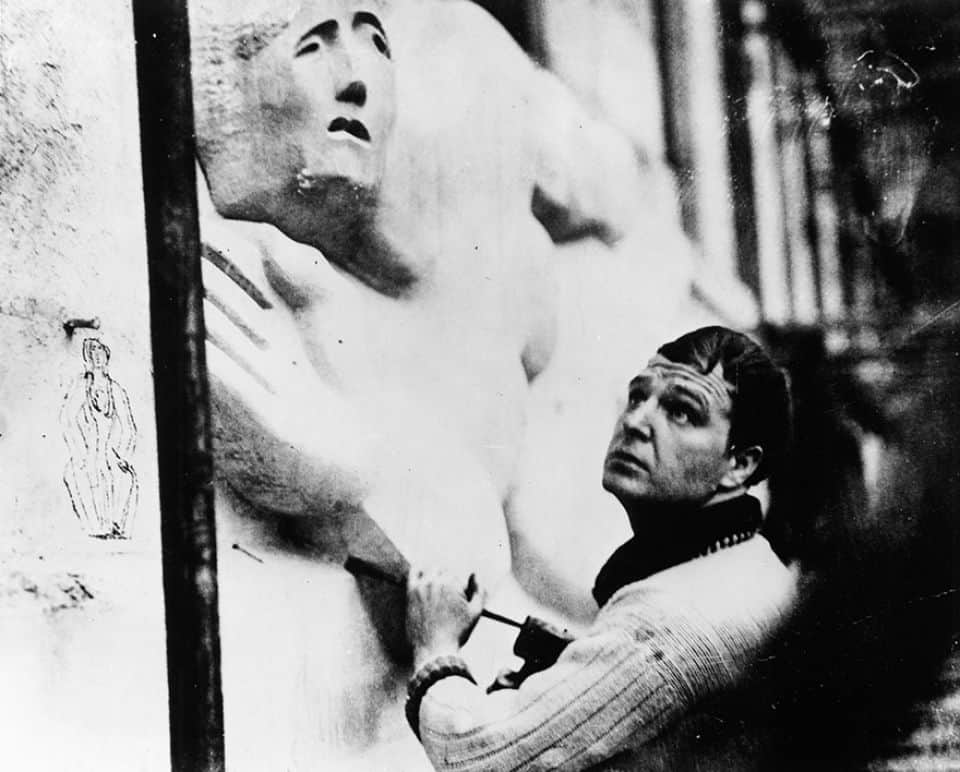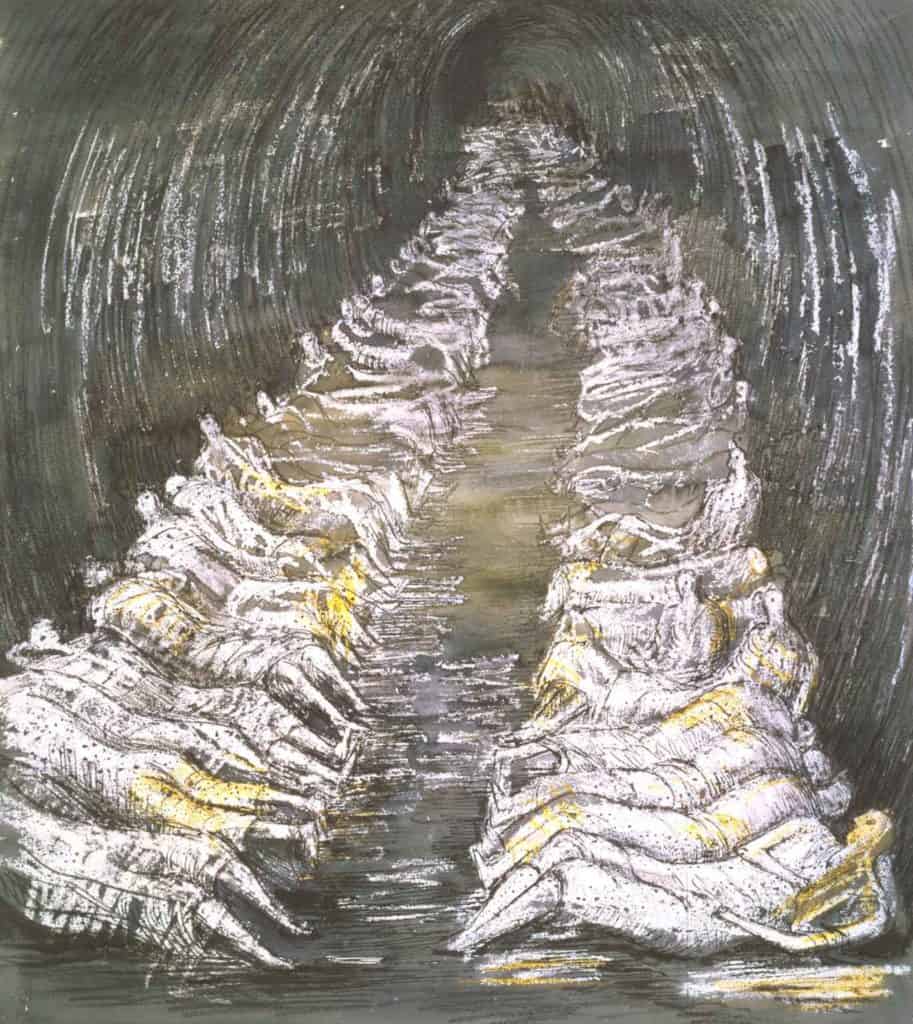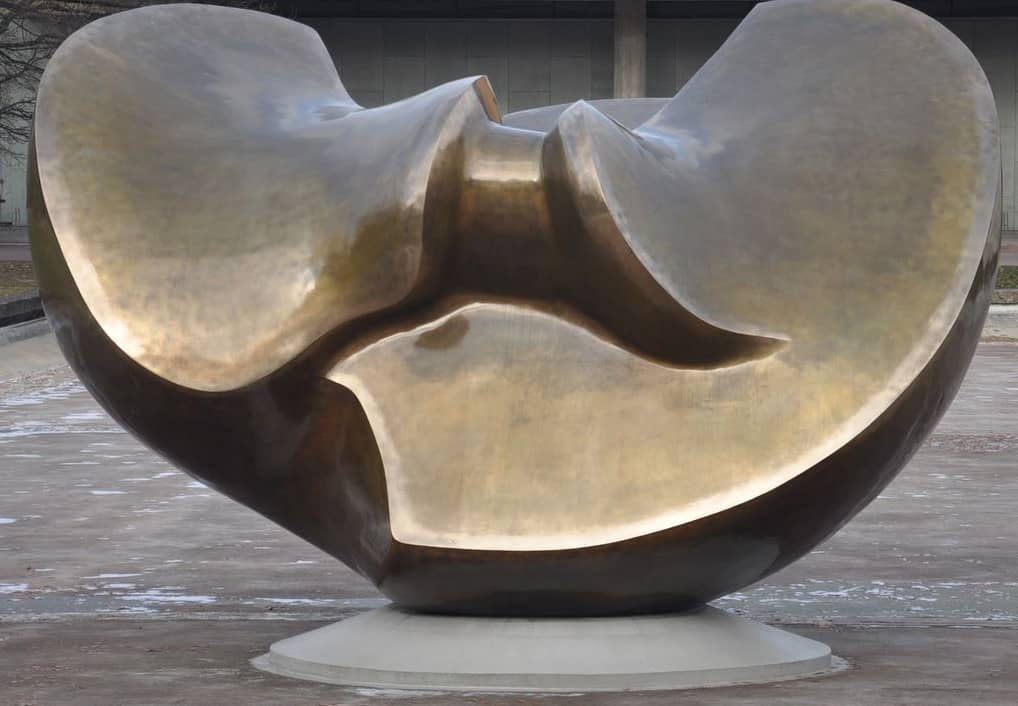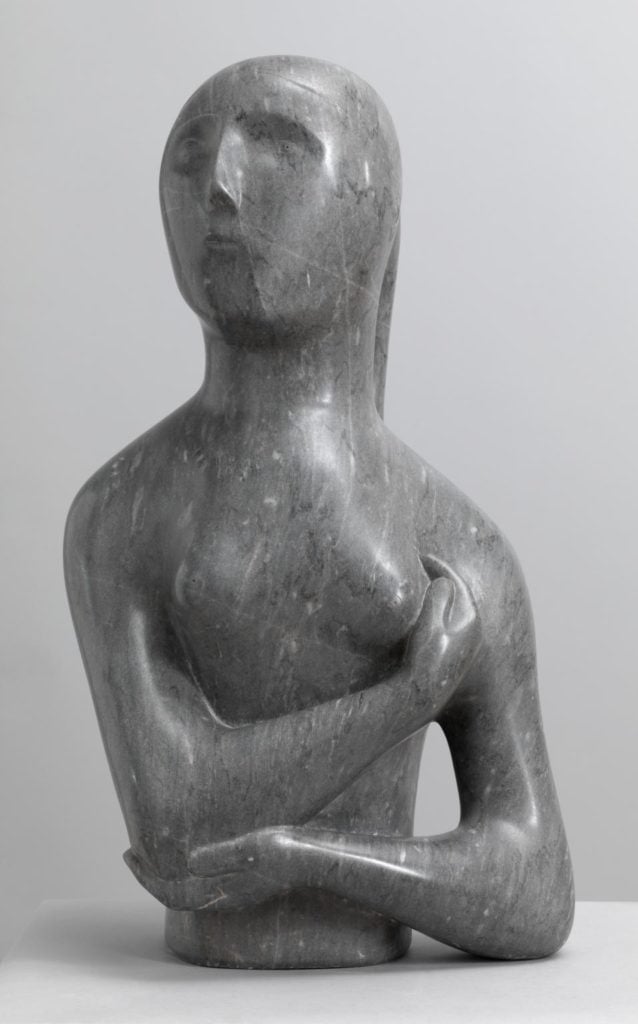Articles and Features
Boundary-Breaking Sculptors of the 20th Century. Henry Moore’s Modernist Sculptures

By Shira Wolfe
“It’s having the idea how to do it that is difficult, not the physical effort.” – Henry Moore
Boundary-breaking sculptors are those who in his or her own way pushed the medium of sculpture forwards into new, unique territories. The first sculptor we discussed in this series was the enigmatic Louise Nevelson. This week, we discuss Henry Moore, one of the most significant sculptors of the 20th century, whose sculptures combined influences from early non-western art with local traditions to create his unique modernist vision.
The Young Henry Moore
Henry Moore, the son of a miner and the seventh of eight children, was born in 1898 in Castleford, Yorkshire. His father, a politically active self-taught miner who loved Shakespeare and taught himself how to play the violin, imparted on Moore the importance of education, culture and a curious mind from an early age. His mother was an important source of stability and protection for Moore, and his recollections of her strong sense of dignity later informed his sculpted female figures.
From an early age, Moore’s artistic talent was recognised by his teachers, and by age 11, after having heard a story about Michelangelo, Moore had decided he wanted to become a sculptor. After he finished secondary school, Moore wanted to study sculpture but his father encouraged him to complete a teacher’s training as it would offer him more job security. At the age of 17, Moore worked as a student teacher at his old elementary school but disliked the experience, and at age 18, he enlisted in the army. Moore was gassed during the Battle of Cambrai in 1917, and returned to England to recuperate. After the war, Moore received an ex-serviceman’s grant to attend the Leeds School of Art, finally enabling him to pursue his artistic dreams.

Henry Moore’s Education in Art
Moore studied drawing and then sculpture at Leeds, and then won a scholarship to study at the Royal College of Art, London. London had been Moore’s dream all along. Here, he was able to absorb all kinds of inspiration and influences to the fullest. In his words: “I knew that not far away I had the National Gallery and British Museum and the Victoria and Albert with the reference library where I could get any book I wanted. I could learn about all the sculptures that had ever been made in the world.” After graduating from the Royal College of Art, Moore taught there on a part-time basis until 1931. It was while teaching at the Royal College in 1928 that Moore met Irina Radetsky, who was studying painting. They got married a year later, and moved to Hampstead, one of London’s artistic hubs at the time. Irina’s opinion and support were extremely important to Moore throughout his career, and he sought her approval for all his work.

The 1920s – A Period of Research and Exploration
The 1920s marked a period of research and exploration for Moore. His personal artistic style began to really take shape, as he assimilated the influences from his student years and his passion for art from early non-western cultures which he researched extensively. Moore’s own unique, modernist aesthetic developed from these different influences. He was interested in the intense vitality of art from early non-western cultures, such as Egyptian, Mexican, Peruvian, African and Oceanic art. He was after a similar “direct and immediate response to life.” This draw to primitive art was also a response to World War I, as it offered a sense of universality and integrity after the brutality and horrors of modern civilisation and industrialisation. Moore distanced himself from the classical tradition and academic modelling, moving away from the naturalistic depiction of flesh and thereby staying true to the materials he worked with. Particularly Ancient Mexican art had a great impact on him, and he cherished and took inspiration from the “stoniness” of pre-Columbian sculpture. Yet Moore paired these strong influences with a preference for working with English stone, which created his unique merging of non-western styles with local tradition.
In 1924, Moore took part in his first group exhibition at Redfern Gallery in London. His first solo exhibition came in 1928 at London’s Warren Gallery, consisting of 42 sculptures and 51 drawings. That same year, he received his first major public commission – a carved relief of the West Wind for the new London Underground headquarters.
Increasing Critique
While he began to become more known in London’s artistic avant-garde circles and his exhibitions were well received, Moore’s modernist aesthetic also proved too unconventional for many artists and critics, and he started to become subject to severe criticism. He resigned from his teaching post at the Royal College of Art in 1931 after a press campaign was launched against him by his colleagues, who said: “Frankly, we think that Mr. Moore’s work is a menace from which students at the Royal College should be protected.” After his resignation, Moore became the first Head of Sculpture in the new sculpture department at Chelsea School of Art.
The criticism didn’t end there. Even decades later, in 1967, when Moore was long considered to be one of the most important sculptors in the world, 17 leading British artists, including his former studio assistant Anthony Caro, wrote to the Times to renounce Moore and everything he stood for. They believed that Moore had both opened up the paths in art that he at the same time blocked off for others. In essence, the problem was that Moore was so in demand that his sculptures were everywhere and many people got tired of looking at them and stopped appreciating their quality. Caro would later say that he regretted taking part in this attack on Moore, acknowledging the great importance and value of his art.


The 1930s – Productivity and Innovation
The 1930s was an incredibly productive and innovative period for Moore, during which time his sculpture underwent significant transformations. He was extremely taken with the theme of Mother and Child, which he considered a universal subject about protection and nurture that continuously offered him new sculptural possibilities. In a compositional sense, he noted the relationship between a small form (the child) with a large form (the mother). There is an ambiguity to the intimacy in Moore’s mother and child figures. Although they are physically connected, they often have heads twisting and looking away while the mother and child’s gaze rarely meet. This is in part due to Moore’s admiration of North American mother and child figures and their unsentimental nature.
The 1930s was also a period in which Moore moved from more literal depictions of the female form to more abstract, allusive forms. He began abstracting and fragmenting his figures, which became more emotionally charged. In some ways, his work was close to Surrealism and its element of surprise, discovery and widening people’s consciousness. For a period, his sculptures became more geometric, while he also started taking inspiration and materials from the natural world.

The Second World War
When the Second World War broke out, Moore abandoned sculpture for drawing. He was commissioned as an official war artist, and his “Shelter Drawings,” drawings of people huddled in London Underground stations to find shelter from the bombing, became well known images in England and internationally. In his drawings of this period, Moore continued to explore themes he had been exploring in his sculpture before: the uncanny, claustrophobia, apprehension and the vulnerable and violated body. When Moore’s street in London was bombed, their studio became damaged and he and his wife Irina moved to a farmhouse in the countryside, which they eventually bought and where they remained for the rest of their lives. Here, Moore had ample space for his large-scale sculptural work.
During the war-period, Moore had his first retrospective exhibition in 1941, and was appointed as trustee of the Tate Gallery. He held his first solo exhibition in New York in 1943, and the first major international retrospective of his work was held in 1946 at the MoMA. This was an important exhibition for Moore that contributed a great deal to the widespread global recognition that followed in the years to come.

“I feel that I can best express myself, that I can best give outward form to certain inward feelings or ambitions by the manipulation of solid materials – wood, stone, or metal. The problems that arise in the manipulation of such materials, problems of mass and volume, of light in relation to form and of volume in relation to space, the problem of continually learning to grasp and understand form more completely in its full spatial reality, all these are problems that interest me as an artist and which I believe I can solve by cutting down, building up or welding together solid three-dimensional materials.” – Henry Moore

Henry Moore’s Materials
In the first period of Moore’s career, he believed firmly in staying true to the materials he was working with. Stone was his preferred material, and instead of trying to create the illusion of actual flesh in the classical tradition, he was interested in following the nature of the stone he was working with. He made a point of using English stone because he believed he should understand the stones from his own country, and because they were cheaper and easy to come by. He also liked using stones that hadn’t before been used for sculpture. Moore liked the anonymous quality of these fairly unknown stones because it fit with the more anonymous mood of the work he was engaged with. Similarly, he had a preference for working with native woods such as beech, box, cherry, walnut and sycamore. Moore explained the love he felt for working with solid materials as follows:
“I feel that I can best express myself, that I can best give outward form to certain inward feelings or ambitions by the manipulation of solid materials – wood, stone, or metal. The problems that arise in the manipulation of such materials, problems of mass and volume, of light in relation to form and of volume in relation to space, the problem of continually learning to grasp and understand form more completely in its full spatial reality, all these are problems that interest me as an artist and which I believe I can solve by cutting down, building up or welding together solid three-dimensional materials.”

Moore worked with an incredible variety of stone throughout his career, always experimenting with new techniques and materials. In later years, he actually began to contradict his previous statements about staying true to the material. He believed these principles had been too restrictive, and started advocating instead for the vision behind the work being the most important thing. He started to appreciate materials such as bronze, which he had previously avoided, understanding that he could do things with bronze that were impossible in stone, for example making more elongated figures and sculptures in editions. He was much more engaged with finding the right material for the particular subject he had in mind. In his words: “In using white marble I give the forms a precision and refinement and a surface finish that I wouldn’t try to obtain with a rough textured stone such as travertine.”

Courtesy Henry Moore Foundation
In his later career, Derek Howarth, one of Moore’s assistants, introduced him to the use of polystyrene as a way to scale up his maquettes into large sculptures. The benefits of the material were that it sped up the process immensely and that it was so light and easy to work with. Moreover, it had a special visual effect with a smooth surface and weightless illusionism. For Moore, working with polystyrene meant saving a lot of time, energy and effort. He could easily make alterations and move the large forms around on his own due to their light weight.

1950s and After – World-Wide Recognition, a Symbol of Post-War Optimism
By 1950, Moore was considered to be the world’s most distinguished modern sculptor. He became known in Britain for a series of Family Groups for the New Towns, which were built following the Second World War to compensate for the many houses that had been damaged by bombing during the war. These sculptures revisited themes of protection and nurture, while other 1950s works reflected more on the concerns, anxieties and disquiet of the post-war era. Moore had become an icon for post-war Britain.
Internationally, important commissions include his marble Reclining Figure, 1957-58 for the UNESCO headquarters in Paris and Nuclear Energy, 1964-66 for the University of Chicago. In 1948, Moore represented Britain at the 24th Venice Biennale, where he was awarded the International Sculpture Prize. His pieces became a representation of the optimistic, humanist values embodied by modernism, which opposed Fascism.
In 1951, Moore became the first living artist to be the subject of a film in the BBC documentary titled Henry Moore. He also had his first retrospective at Tate in London. In 1952, he was again represented at the Venice Biennale. This time, the British Council installed Moore’s work at the entrance to the pavilion, and then presented a new group of emerging sculptors inside the pavilion, thereby positioning Moore as the forefather of the younger group of British artists. These artists came to be known as the “Geometry of Fear” artists, and were actively moving away from Moore’s style and approach with their disturbing welded, spiky forms. Like so many artists, they were attempting to escape the shadow of Moore.


Henry Moore’s Legacy
Henry Moore was championed more than any other artist by the British Council. In this sense, he was both blessed and cursed: he was extremely successful and his sculptures were shown all over the world, but he was also despised by countless fellow artists who felt he overshadowed them. Yet this never deterred him, and his legacy is magnificent, with the Henry Moore Foundation to oversee the sale and exhibiting of his work, the Henry Moore Centre in Ontario, the Henry Moore Sculpture Gallery and Centre for the Study of Sculpture in Leeds, and his donation of sculptures and graphics to Tate. Highlights of Moore’s sculptures around the globe include: “Wall Relief” from 1955 on the Bouwcentrum, Rotterdam; “Reclining Woman” at the National Gallery of Canada, Ottawa; “Memorial Figure” at Dartington Hall, Devon; “King and Queen” at Museum of Art Atami, Japan; “Butterfly” at Haus der Kulturen der Welt, Berlin and “Two-Piece Reclining Figure II” at Kröller-Müller Museum in Otterlo, the Netherlands. Moore passed away in 1986 at the age of 88.

Relevant sources to learn more
For in-depth insight into Moore’s artistic production, life and legacy, see: